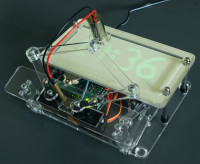Laser Time Writer

The laser plot clock writes the time on a piece of glow in the dark sticker material using a violet laser module.
The laser plot clock is a variant of the earlier published sand clock. This clock doesn't write the time in a layer of sand, it rather uses a 5 mW violet (405 nm) laser module to plot the time onto a piece of glow in the dark sticker material.
The afterglow time of the glow in the dark material is dependent on the ambient light conditions. The best performance is achieved under normal room light conditions. The material used for the prototype glows green but other colors are possible.
In order to get everything running, a few modifictions to the original design were necessary. The laser module runs on 3 - 5 V and seems to have some kind of built-in switching regulator as the supply current increases when the supply voltage decreases.
To avoid interference with the servo motors, we hooked up the laser module between the Arduino 5 V power rail and the negative connection for the vibration motors. The base resistor R4 was lowered to 1K, otherwise T1 can't deliver enough current to start the laser module. In addition, a switch was connected between pin 6 of the Arduino and ground that allows starting the writing sequence at will rather than at a preset interval.
The arms of the pantograph mechanism were extended a bit, each segment is now 5 mm longer. This enables the sketch to write the time (or text) upside down or mirrored in future software releases.
Finally we modified the original sand clock software to get it running with the new hardware. This is a first release, updates with extended functionality will follow.
You can see a video of the laser plot clock in action on Youtube.
The afterglow time of the glow in the dark material is dependent on the ambient light conditions. The best performance is achieved under normal room light conditions. The material used for the prototype glows green but other colors are possible.
In order to get everything running, a few modifictions to the original design were necessary. The laser module runs on 3 - 5 V and seems to have some kind of built-in switching regulator as the supply current increases when the supply voltage decreases.
To avoid interference with the servo motors, we hooked up the laser module between the Arduino 5 V power rail and the negative connection for the vibration motors. The base resistor R4 was lowered to 1K, otherwise T1 can't deliver enough current to start the laser module. In addition, a switch was connected between pin 6 of the Arduino and ground that allows starting the writing sequence at will rather than at a preset interval.
The arms of the pantograph mechanism were extended a bit, each segment is now 5 mm longer. This enables the sketch to write the time (or text) upside down or mirrored in future software releases.
Finally we modified the original sand clock software to get it running with the new hardware. This is a first release, updates with extended functionality will follow.
You can see a video of the laser plot clock in action on Youtube.



Mises à jour de l'auteur